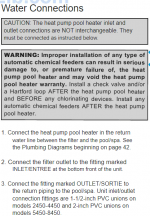I want to be able to shut the water off completely to the heater when not being used, which is most of the time and all winter in AZ. The way the valve is set up, it appears there is no way to do this.
The heater is also short cycling- I don't understand how to adjust the flow volume to the heater to stop the short cycling because the setup doesn't make sense to me as far as a bypass to the heater. I am guessing there is a way to turn the valve so off is at the outlet to the heater? Any help is appreciated. The pool contractor (sole proprietor) is being incredibly difficult and claiming none of his other customers have problems with the heater and refuses to label or explain how all the valves function.
The heater is also short cycling- I don't understand how to adjust the flow volume to the heater to stop the short cycling because the setup doesn't make sense to me as far as a bypass to the heater. I am guessing there is a way to turn the valve so off is at the outlet to the heater? Any help is appreciated. The pool contractor (sole proprietor) is being incredibly difficult and claiming none of his other customers have problems with the heater and refuses to label or explain how all the valves function.





